Learn how to make sushi rice perfectly every time with step-by-step pictures and a video tutorial. All you need are simple ingredients such as rice vinegar, sugar, salt, and kombu. Once you master the secret of making the sushi rice, you will be ready to dish up all kinds of mouth-watering sushi recipes!
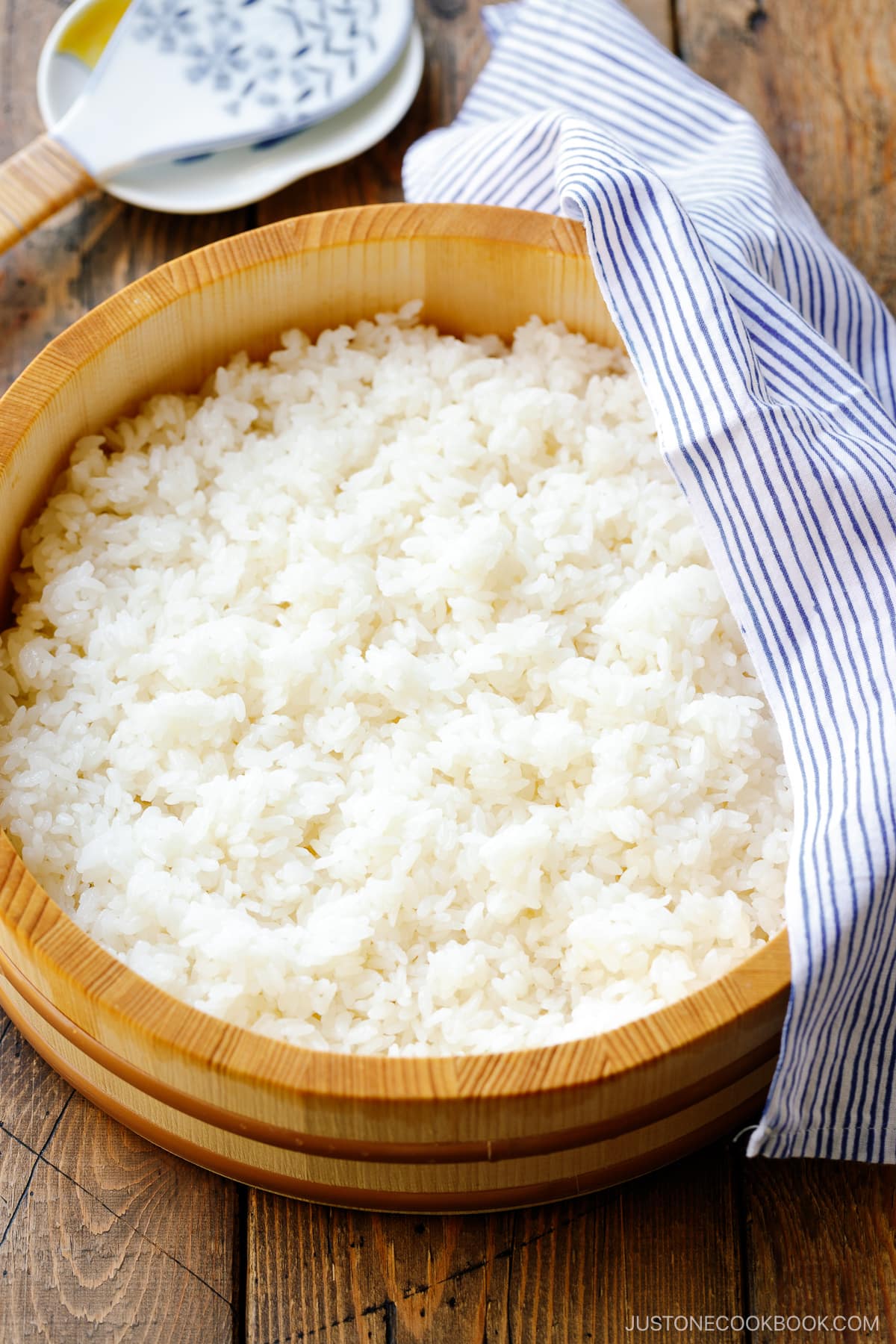
Perfectly cooked Sushi Rice (酢飯) is fundamental in making any form of sushi. Indeed, the best sushi restaurants in Japan pride themselves not only on the freshest fish or variety but on the technique and quality of the sushi rice. Here, I shared my secrets and techniques on how to make sushi rice the authentic way. Follow along, and you’ll be able to make the best sushi rice at home for all kinds of sushi!
Table of Contents
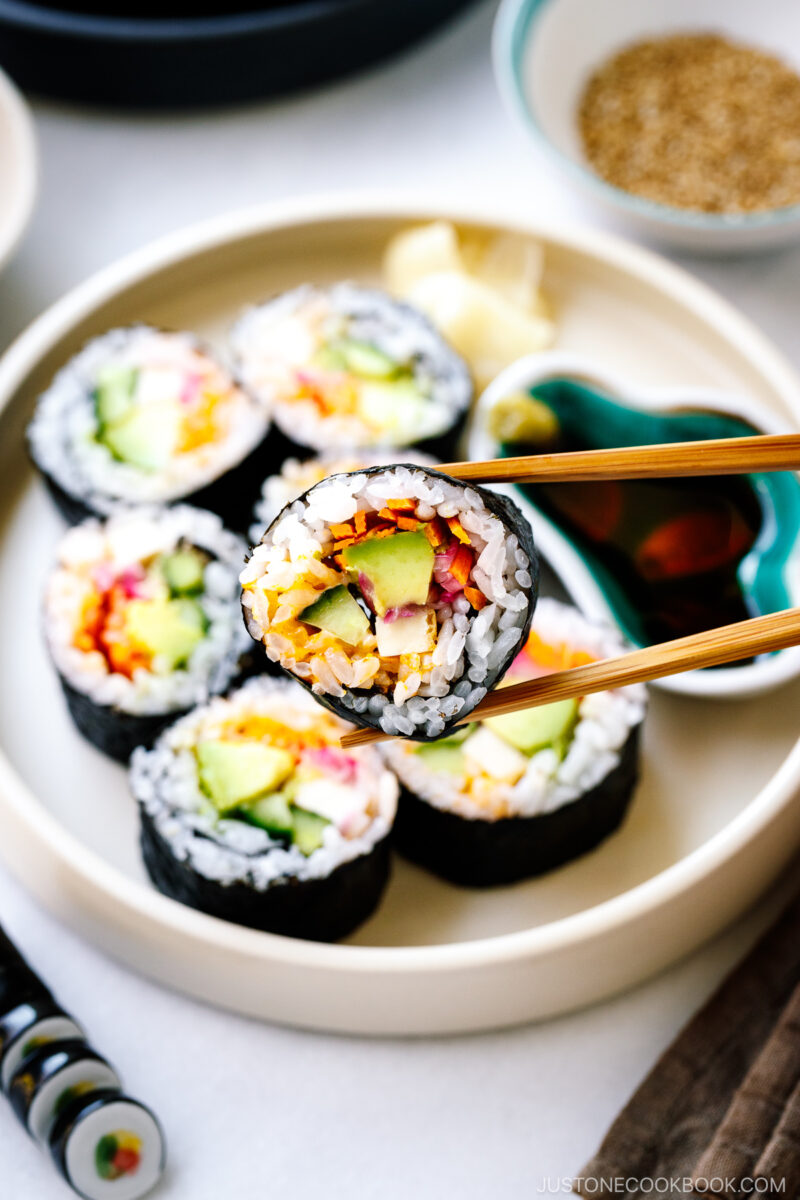
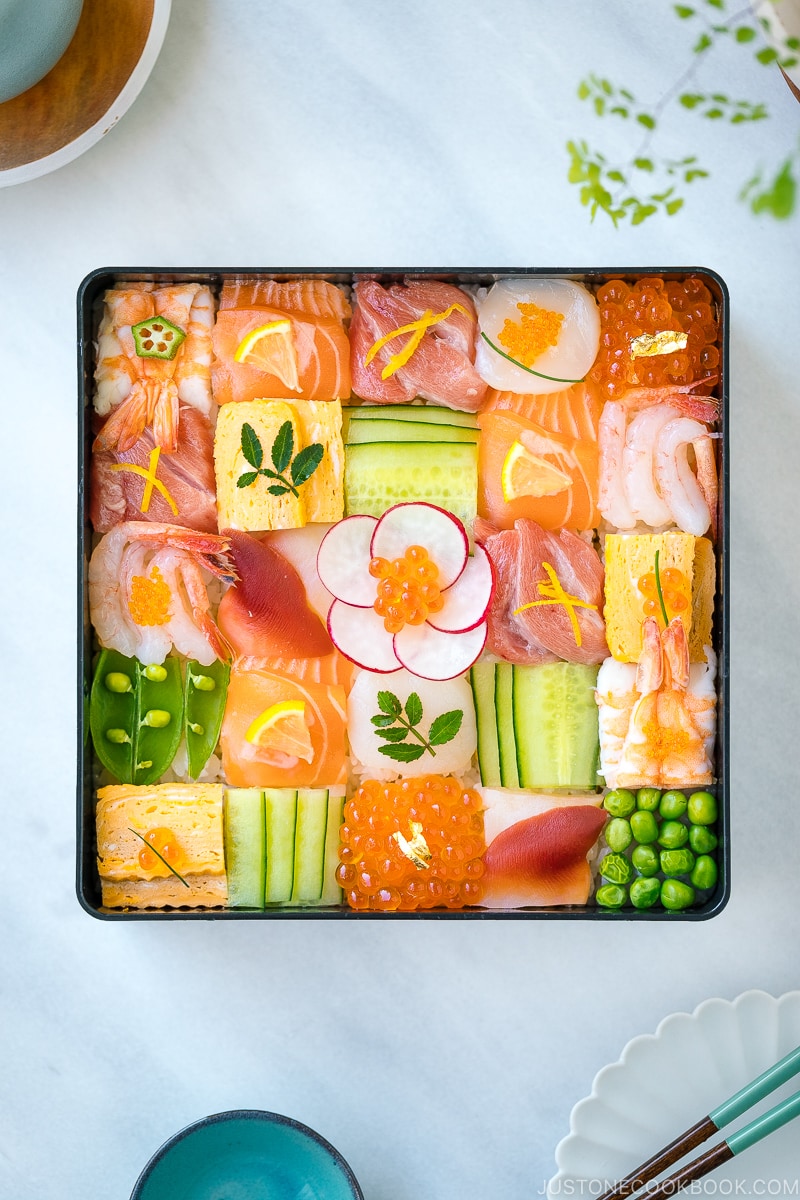
What is Sushi Rice?
Sushi rice is made by cooking Japanese short-grain rice with kombu (kelp), which is then seasoned with a mixture of rice vinegar, sugar, and salt. In Japanese, sushi rice is also known as sushi-meshi (鮨飯), su-meshi (酢飯), or shari (シャリ). We only use this vinegar-flavored rice when making all kinds of sushi.
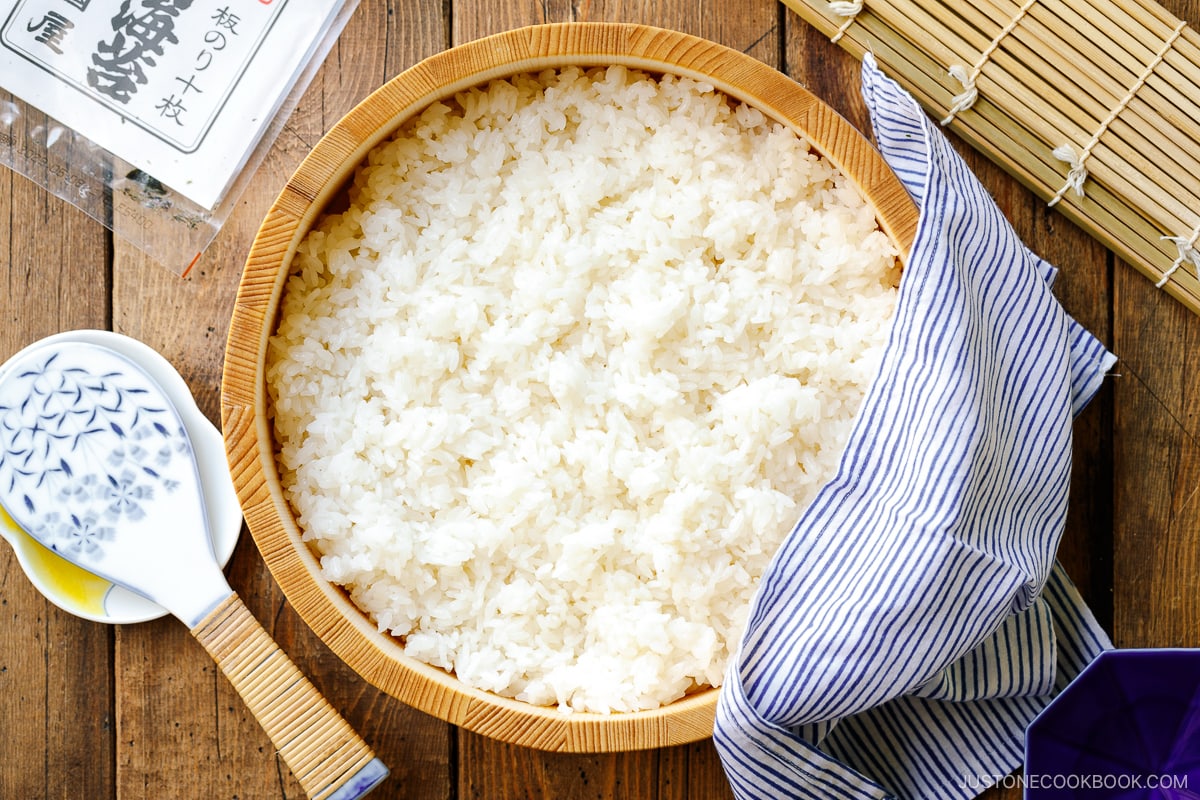
It’s worth noting that outside of Japan, Japanese short-grain rice is often called “sushi rice” for marketing purposes. In reality, Japanese rice is typically used in everyday meals and less often in sushi recipes.
You may also notice that Japanese short-grain rice has been incorrectly called “sticky rice.” Sticky rice is actually another name for glutinous rice or short-grain Japanese mochigome. We use this type of glutinous rice to make Mochi, Sekihan, and Okowa.
👉🏼 If you are here looking for a recipe to make plain steamed rice, see my post on How to Make Rice.
👉🏼 To brush up on your knowledge, I highly recommend reading “Everything You Need to Know about Japanese Rice” and “Types of Japanese Rice.“
Why Do We Season the Steamed Rice with Vinegar?
This actually goes back to the origin of sushi. The literal meaning of sushi is “sour flavor.” Historically, the way people stored fish was by wrapping it in fermented rice. When they were ready to enjoy the fish, the fermented rice was tossed away.
Sometime between the 1300s and 1500s, the Japanese slowly stopped using fermented rice and instead added vinegar to the rice to further increase its shelf life. The vinegar ended up improving the flavor of the rice so they started eating the fish and the rice together, which evolved to today’s sushi.
These days with refrigeration, there is no longer a spoilage issue with the fish, but the centuries of flavoring the rice with vinegar have become the mainstay.
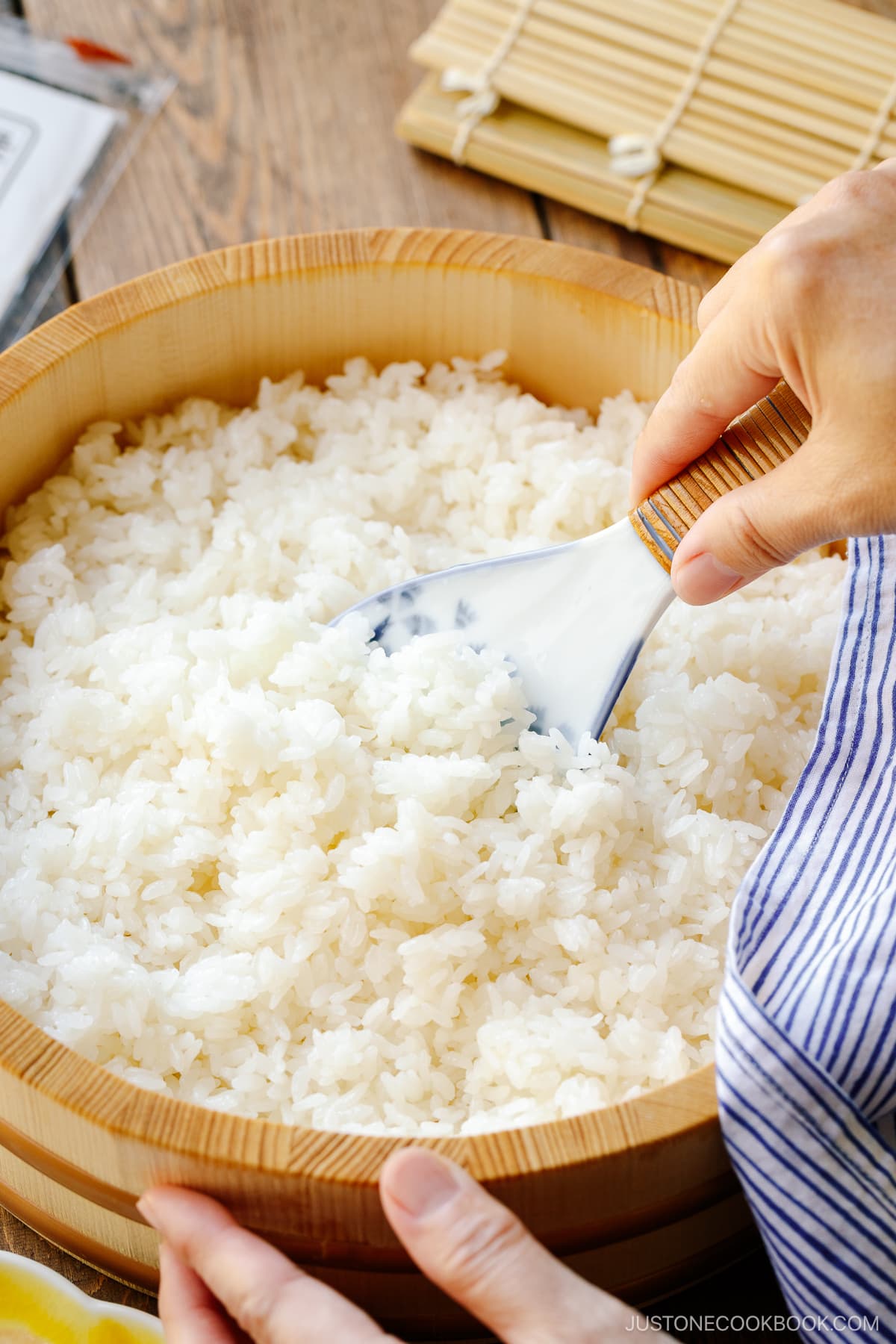
Where to Buy Japanese Short-Grain Rice
You can find Japanese short-grain rice, commonly labeled as sushi rice, in major grocery stores these days. Some standard, affordable brands like Kokuho Rose and Nishiki are medium-grain rice.
For premium brands, I recommend Tamaki Gold and Tamanishiki Super Premium Short Grain Rice, which are available in Asian grocery stores.
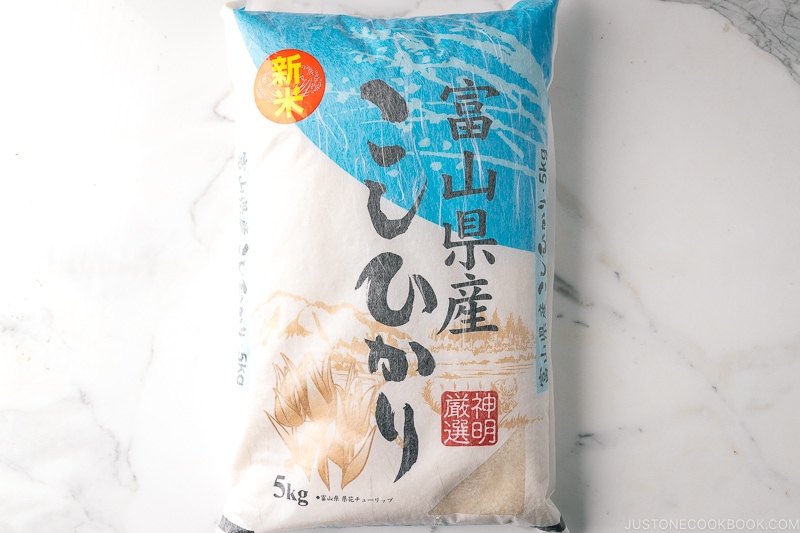
If you’re looking for imported, high-quality rice from Japan, I would recommend the Koshihikari variety, which is available from various brands at Japanese grocery stores. Known for its sweet taste and fragrance, it is the most popular variety in Japan.
My family and I like the Koshihikari rice from Toyama prefecture (see above). Nijiya Market sells it and we think it’s one of the best imported rice available here in the U.S. at this time.
The Right Rice-to-Water Ratio
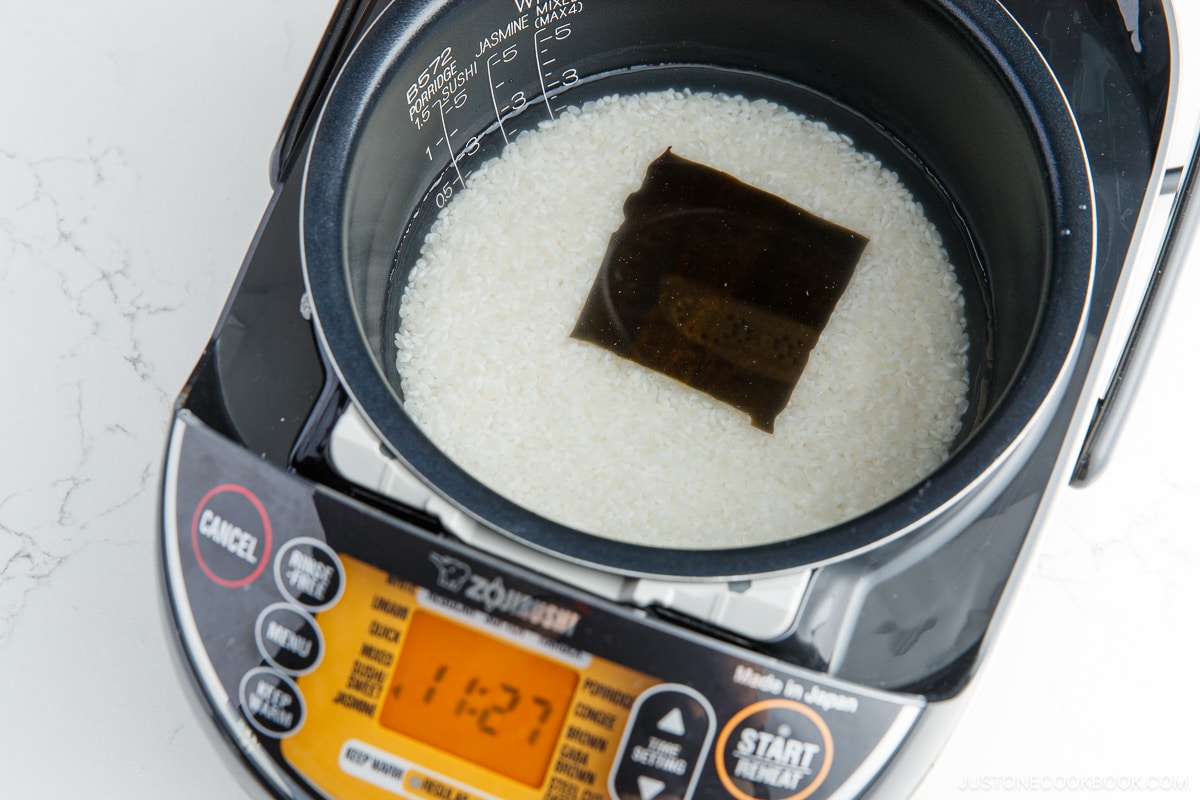
When cooking rice normally, the Japanese golden ratio for white rice to water is 1 to 1.1 (or 1.2).
However, when making sushi rice (for all kinds of sushi recipes), it is very important to leave room for the sushi vinegar to soak into the cooked rice. For that reason, the amount of water to cook the short-grain rice is slightly moderated.
To make sushi rice, the golden ratio for white rice to water is 1 to 1.
Also, The rice should be cooked slightly harder and the steaming time should be shortened.
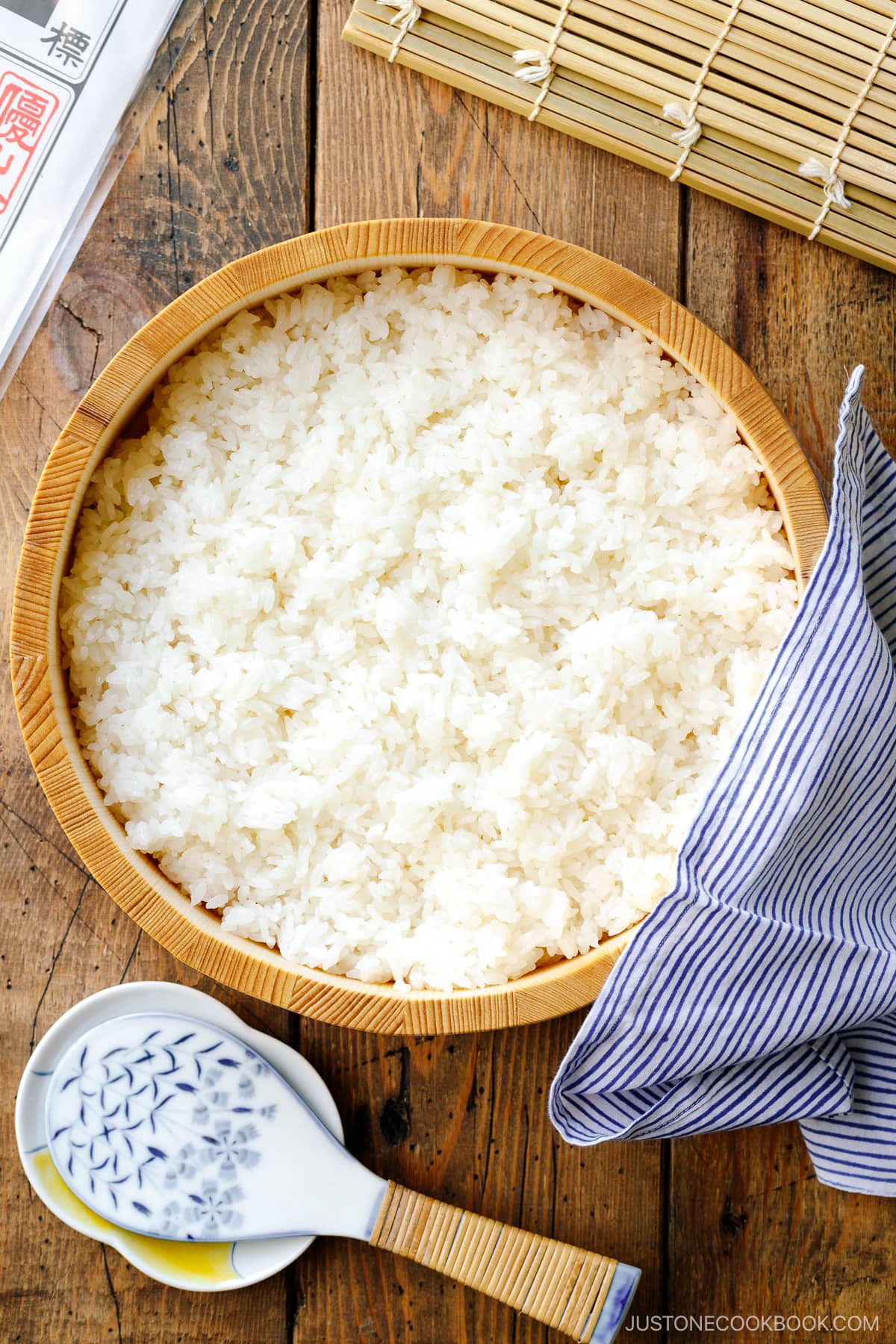
How to Make Perfect Sushi Rice
The Ingredients You’ll Need
- Japanese short-grain rice
- Kombu (kelp) – optional, but it infuses your rice with a nice aroma
- Rice vinegar
- Sugar
- Salt
The Cooking Steps
- Cook rice with kombu using your preferred cooking method.
- Make “sushi vinegar” seasoning.
- Transfer cooked rice to a baking sheet lined with parchment paper or a sushi oke or hangiri (traditional method).
- Season the rice with “sushi vinegar.” Then, fluff the rice with a rice paddle using a slicing motion.
- Cover with a damp towel and ready to use.
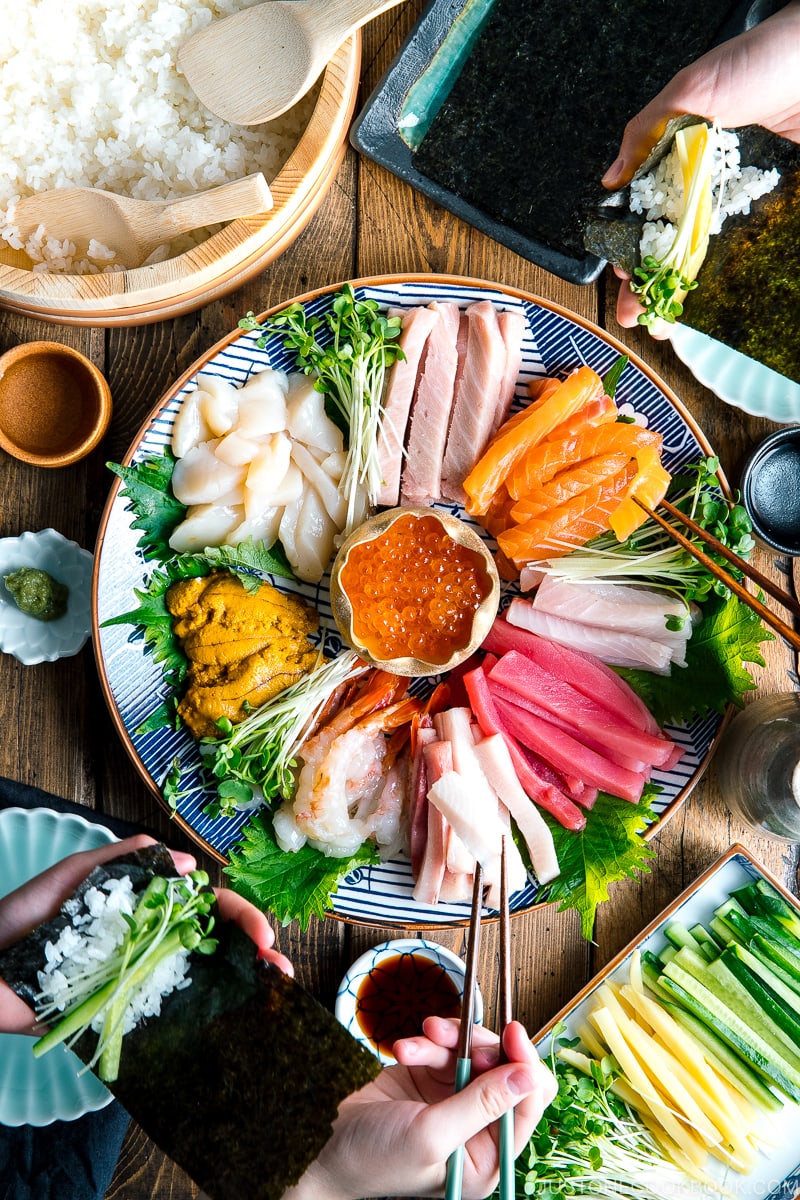
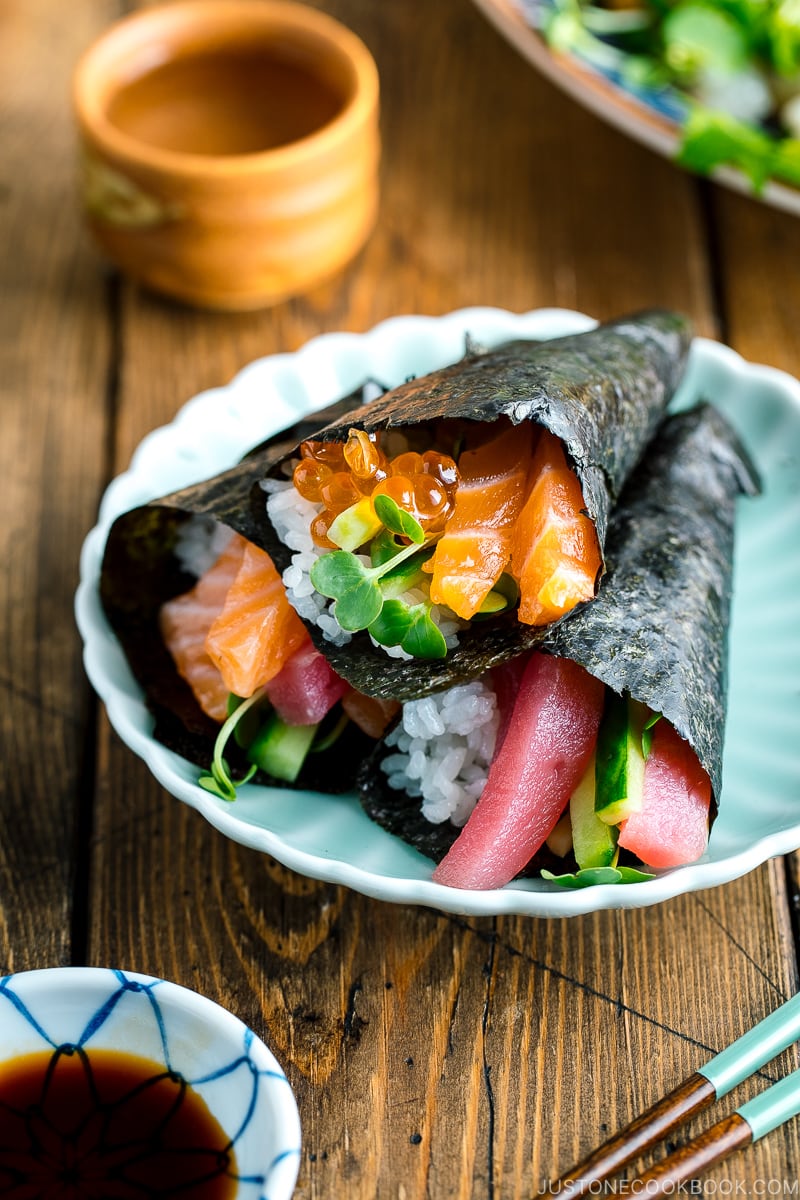
How Much Rice Do I Need to Cook?
The plastic rice cooker cup that comes with the rice cooker is ¾ cup (180 ml). In Japan, this amount is called ichi go (一合).
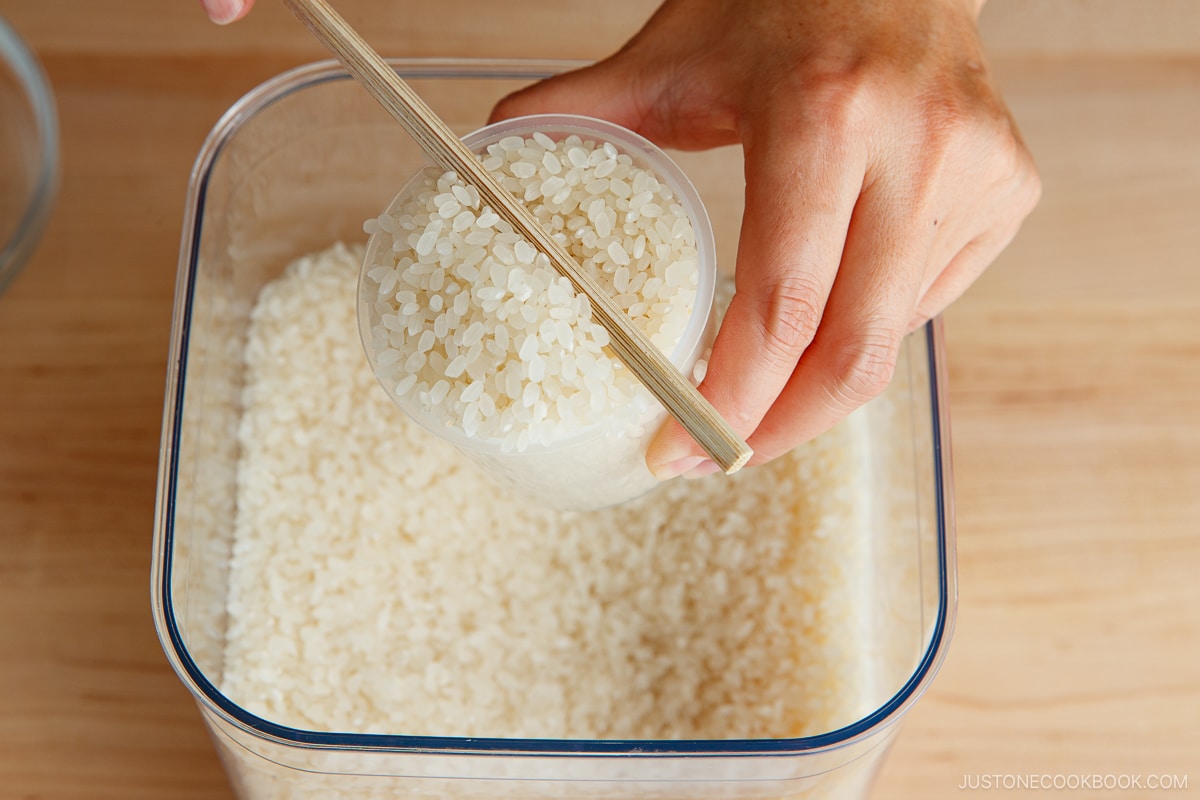
- 1 rice cooker cup (180 ml, ¾ cup, 150 g) of uncooked rice
- 2¼ cups or 330 g of cooked rice
- 1 thick sushi rolls
- 2 medium sushi rolls
- 4 thin sushi rolls
- 3 inside-out rolls
- 2¼ cups or 330 g of cooked rice
- 2 rice cooker cups (360 ml, 1½ cups, 300 g) of uncooked rice
- 4⅓ cups, 660 g of cooked rice
- 2 thick sushi rolls
- 4 medium sushi rolls
- 8 thin sushi rolls
- 6 inside-out sushi rolls
- 4⅓ cups, 660 g of cooked rice
- 3 rice cooker cups (540 ml, 2¼ cups, 450 g) of uncooked rice
- 6⅔ cups or 990 g of cooked rice
- 4 thick sushi rolls
- 6 medium sushi rolls
- 12 thin sushi rolls
- 9 inside-out sushi rolls
- 6⅔ cups or 990 g of cooked rice
- 4 rice cooker cups (720 ml, 3 cups, 600 g) of uncooked rice
- 8¾ cups or 1320 g of cooked rice
- 5 thick sushi rolls
- 8 medium sushi rolls
- 16 thin sushi rolls
- 12 inside-out sushi rolls
- 8¾ cups or 1320 g of cooked rice
- 5 rice cooker cups (900 ml, 3¾ cups, 750 g) of uncooked rice
- 11 cups or 1650 g of cooked rice
- 6 thick sushi rolls
- 11 medium sushi rolls
- 20 thin sushi rolls
- 15 inside-out sushi rolls
- 11 cups or 1650 g of cooked rice
Helpful Notes to Remember:
- One thick sushi roll (Futomaki) requires 1⅔ cups (250 g) of sushi rice.
- One medium sushi roll (Chumaki) like Vegetarian Sushi Roll requires 1 cup (150 g) of sushi rice.
- One thin sushi roll (Hosomaki) requires ½ cup (80 g) of sushi rice.
- One inside-out sushi roll (Uramaki) like California Roll requires ¾ cup (110 g) sushi rice.
- One nigiri sushi requires 20 g of sushi rice.
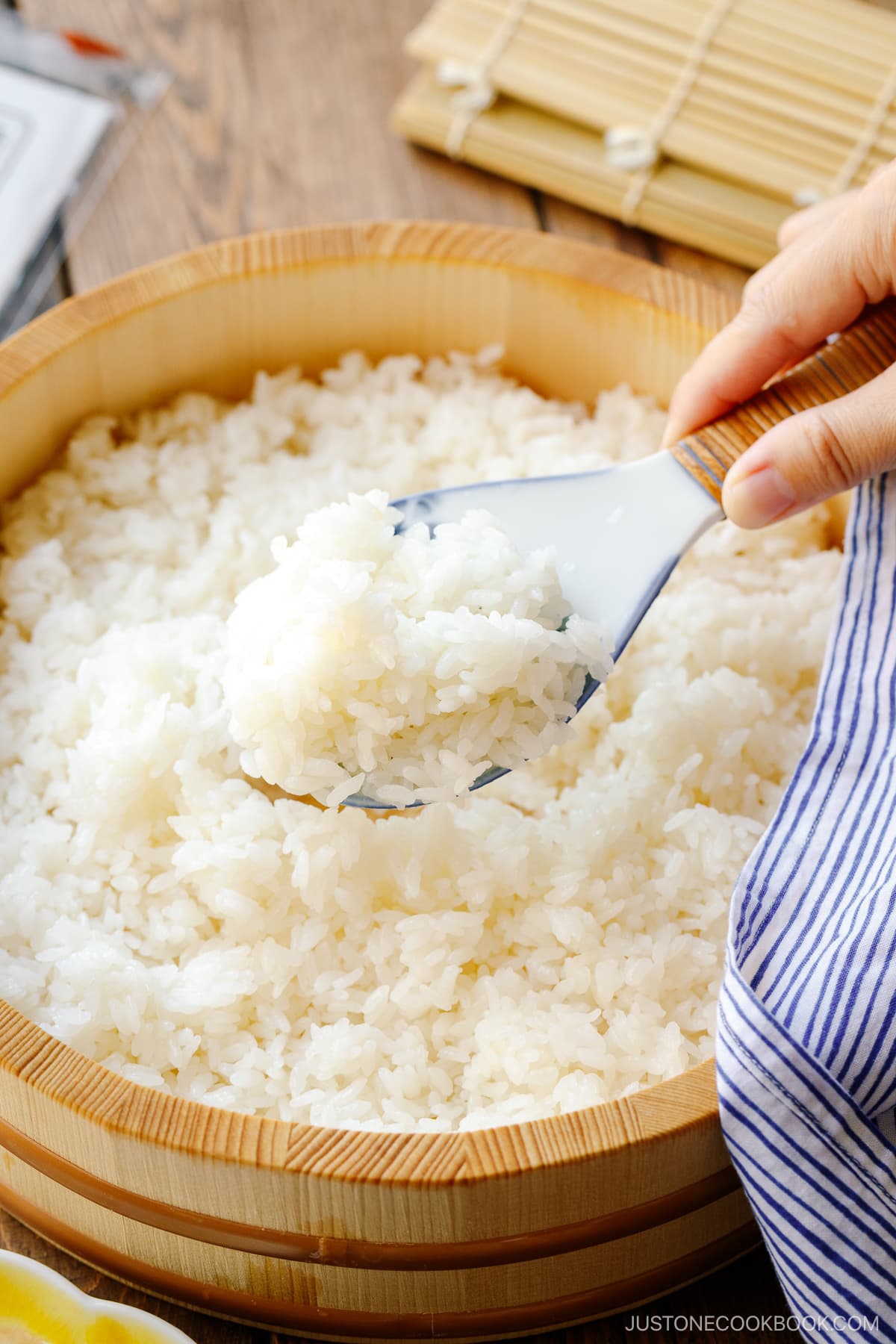
Cooking Tips
- Use Japanese short-grain rice. To achieve an authentic Japanese standard, you want to use only short-grain Japanese rice to make sushi rice. This is because the consistency and flavor of Japanese rice are very different from long-grain rice, jasmine rice, or other types of rice. With a higher content of moisture, Japanese rice is characterized by its unique stickiness and texture, which is attributed to the toothsome bite of authentic sushi. Read more about rice on my pantry page.
- Rinse and soak the rice before cooking. Make sure the rice is washed and rinsed a few times until no more starch comes out from the water. Then let the rice be soaked for at least 20-30 minutes before cooking. This allows the rice grains to yield a better texture.
- Cook the rice with kombu. Kombu (dried kelp) gives a subtle fragrance and umami taste to the sushi rice.
- The rice-to-water ratio is 1:1 (volume). Because we add sushi vinegar to the cooked rice, we use a bit less water than when you cook the rice regularly.
- Make homemade sushi vinegar. Sushi rice is always seasoned with sushi vinegar. It’s made of rice vinegar, sugar, and salt to achieve a balance of sweet, salty, and sour taste. You need to get mild-flavored rice vinegar, not another type of vinegar for this; otherwise, it’s too strong and the flavor is not the same. If you want to save time, you can use a bottle of seasoned vinegar called sushizu (すし酢).
- Transfer cooked rice to a sushi oke (hangiri), a large salad bowl, or a baking sheet lined with parchment paper. You must let the rice cool fast. It’s common to use an electric fan or hand-held fan called uchiwa (うちわ) to cool the rice.
- Add sushi vinegar when the rice is hot. As soon as the rice is taken out of the rice cooker or the cooking pot, you have to season the rice with sushi vinegar.
- Fluff the rice in a slicing motion with a rice paddle. Don’t mix or else sushi rice will end up being mushy or smashed. With proper fanning and slicing, your sushi rice becomes shiny!
- Cover with a damp towel and keep it at room temp until you’re ready to make sushi.
What Does Perfectly Cooked Rice Look Like?
After the rice is steamed, the rice should be shiny and plump. The texture should be fluffy with a firm bite. And each rice grain should be sticky yet retain its shape. Mushy rice means it has too much water or it is overcooked. If the rice is fresh, you will see a nice shiny gloss on the surface of each grain.
Sushi Oke (Hangiri) – A Wooden Tub
The wooden tub that is used to season, mix, and cool sushi rice is called sushi oke (寿司桶) or hangiri (はんぎり). It has straight edges and a flat bottom, which assists in spreading hot rice and allowing it to cool after adding sushi seasoning. The Hinoki cypress absorbs excess moisture.
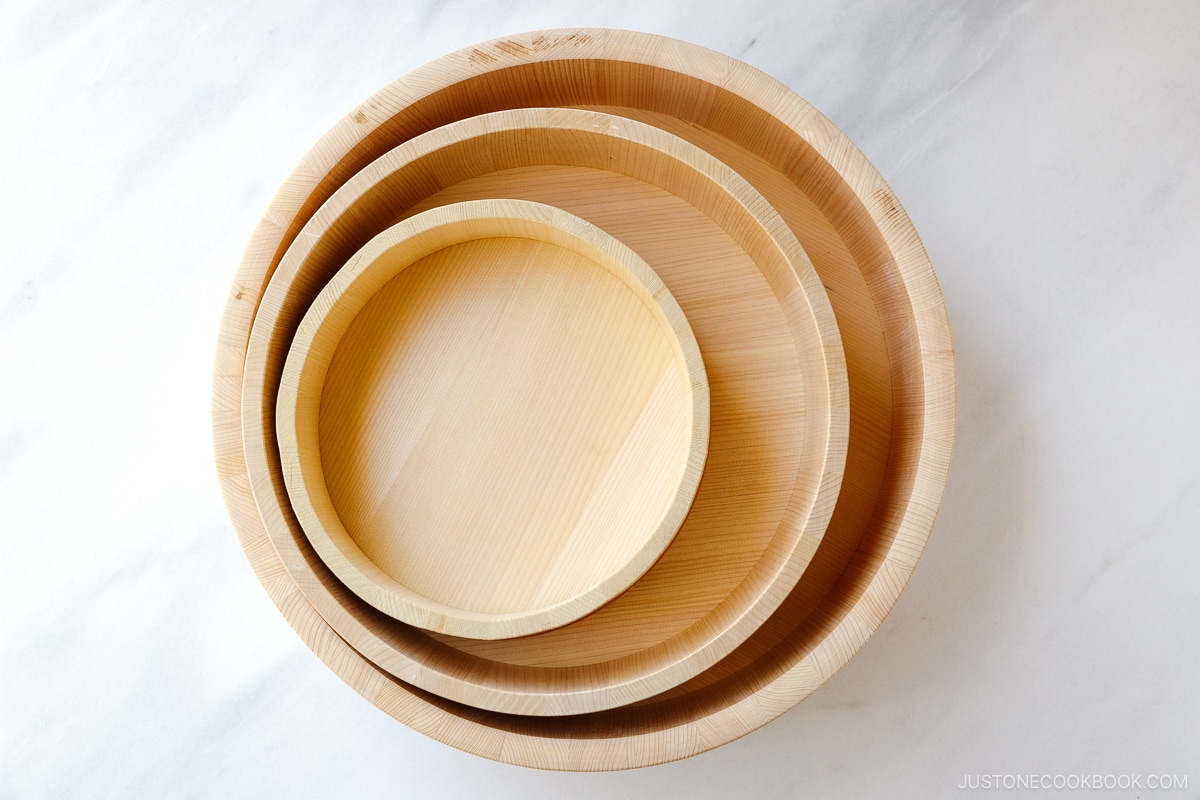
- 17 inch – MTC Kitchen (Use JOC10 to get 10% off)
- 14 inch – Amazon
- 10 inch – Amazon
Best Way to Store Cooked Rice
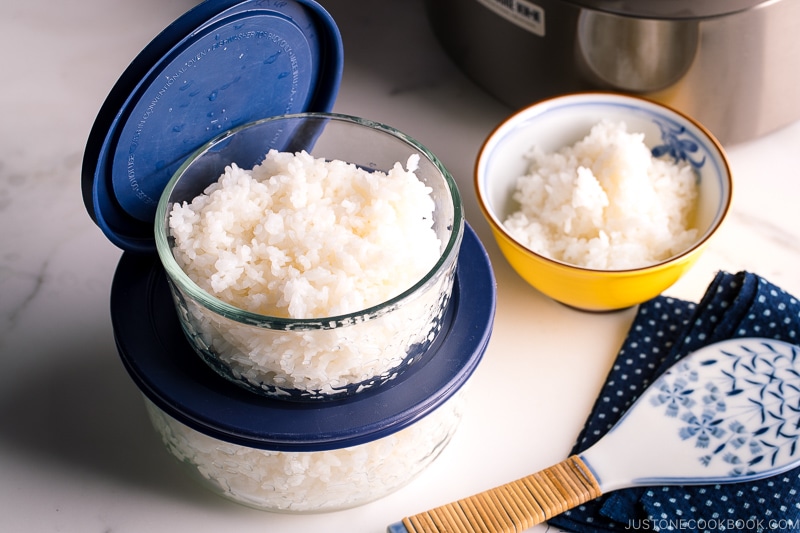
What’s the best method to store cooked sushi rice? Simply freeze the sushi rice in airtight containers and bring it back to room temperature when you need it to make sushi! This is by far the best approach to keeping your sushi rice fresh and moist. Do not refrigerate it!
Other Methods of Cooking Japanese Rice
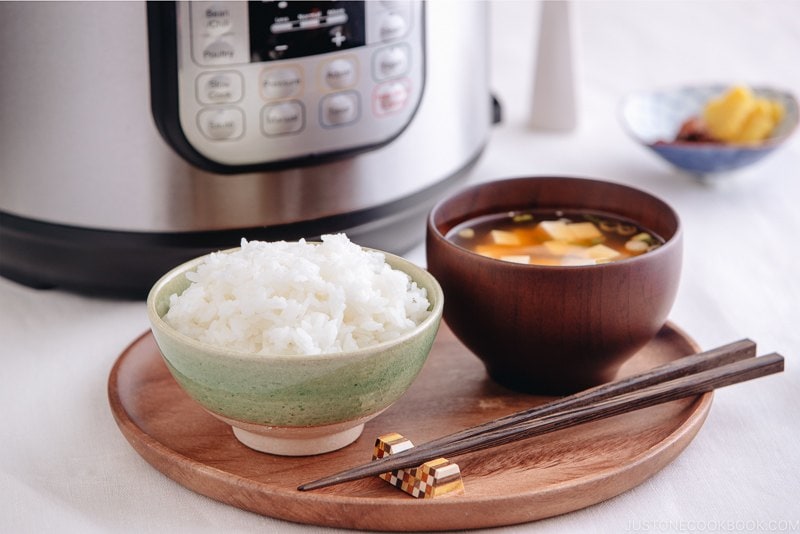
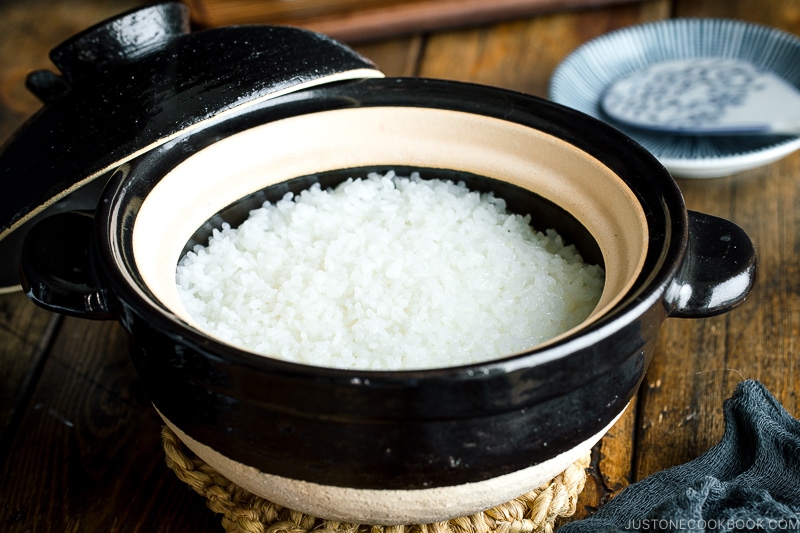
You can cook the rice using a pot over the stove, but the most convenient way is to cook sushi rice using an electric rice cooker. In my Japanese home kitchen, my trusted rice cooker brand is Zojirushi Rice Cooker. Because I cook sushi rice often, this rice cooker has a ‘sushi’ option, which makes it really easy to ensure the rice is cooked perfectly. Here are my recipes for different cooking options.
- How to Cook Rice in a Rice Cooker
- How to Cook Rice in a Pot over the Stovetop
- How to Cook Rice in an Instant Pot
- How to Cook Rice in a Donabe
Delicious Sushi Recipes
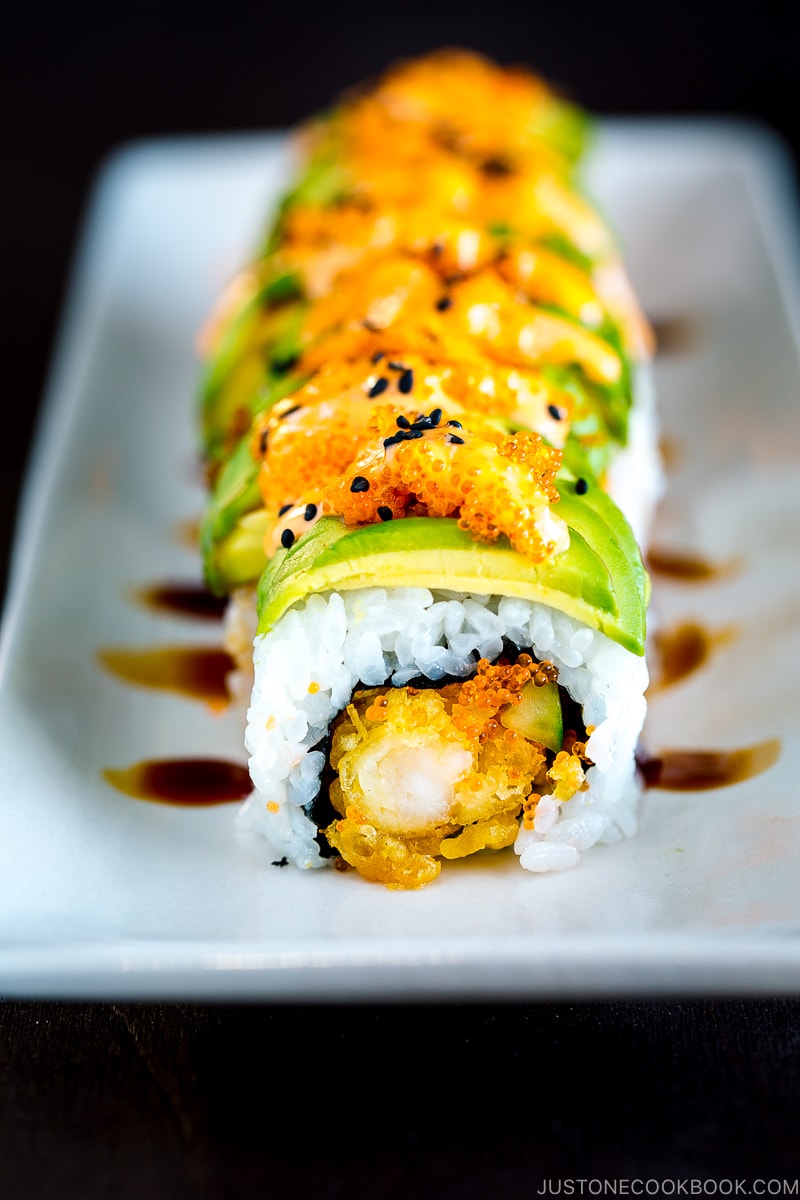
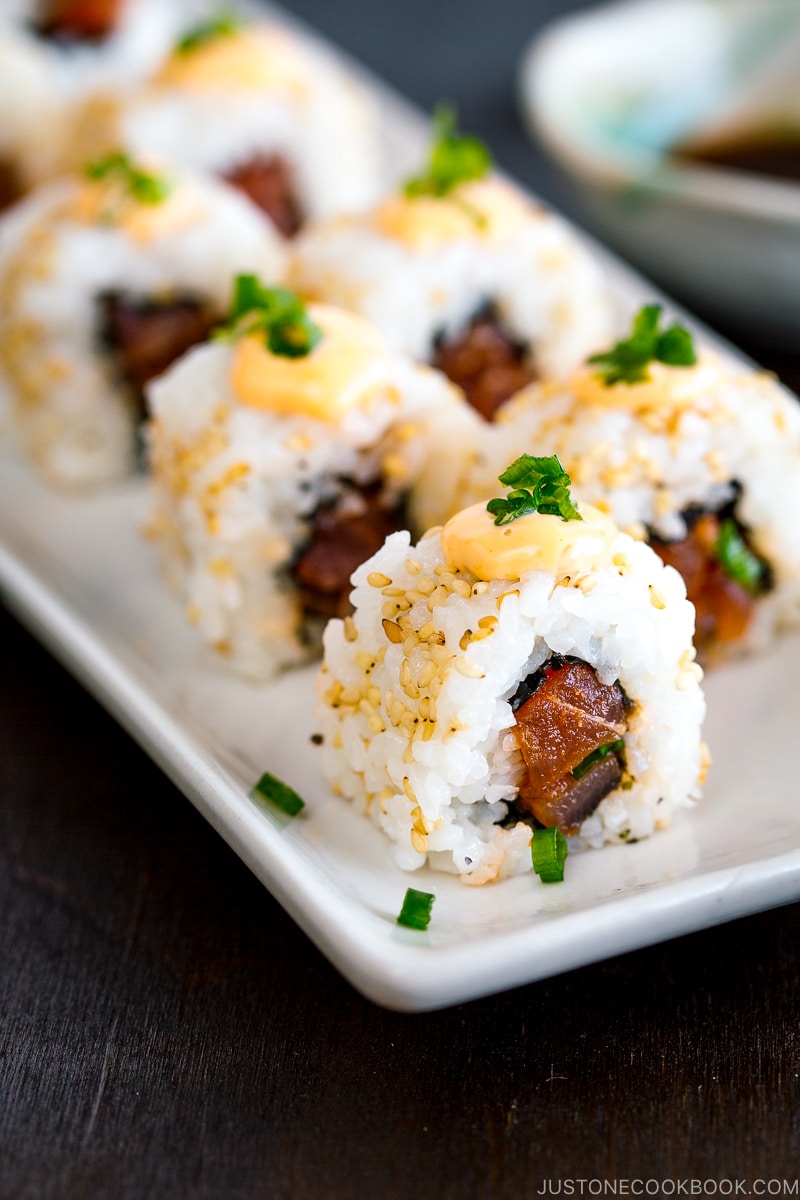
Now with perfectly cooked sushi rice, you can make all kinds of sushi recipes! If you are interested in learning more, check out my post Learning at Sushi Skills Seminar in San Francisco.
- California Roll
- Dragon Roll
- Spicy Tuna Roll
- Yellowtail Tuna Roll (Negihama Maki)
- Hosomaki (Thin Sushi Roll)
- Futomaki (Thick Sushi Roll)
- Chirashi Sushi
- Saba Oshizushi (Mackerel Pressed Sushi)
- Inari Sushi
- Temaki Sushi (Hand Roll)
- Temari Sushi
- Mosaic Sushi
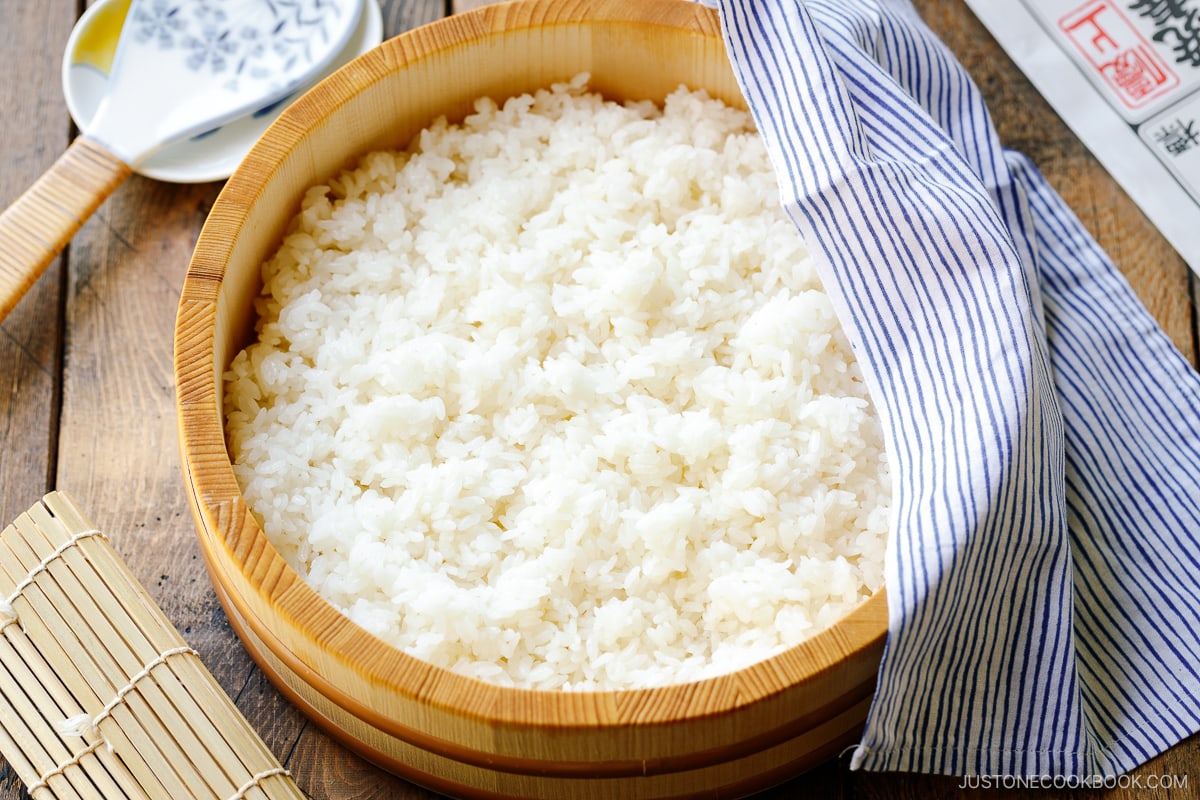
Wish to learn more about Japanese cooking? Sign up for our free newsletter to receive cooking tips & recipe updates! And stay in touch with me on Facebook, Pinterest, YouTube, and Instagram.
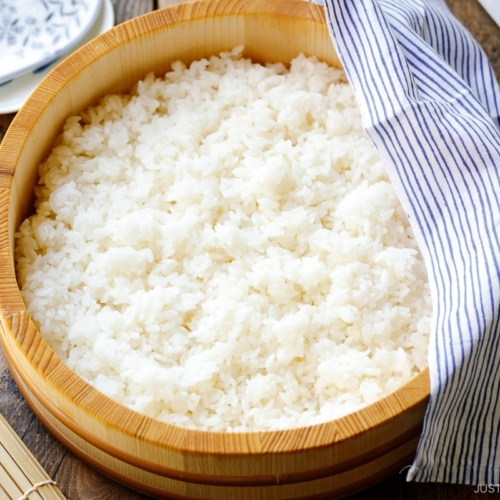
How to Make Sushi Rice (for Sushi Recipes)
Video
Ingredients
★ For 5–6 Servings (Makes 6 Medium Sushi Rolls)
- 2¼ cups uncooked Japanese short-grain white rice (3 rice cooker cups; 540 ml; yields 6⅔ cups or 990 g of cooked rice)
- 2¼ cups water (540 ml)
- 1 piece kombu (dried kelp) (5 g per piece; 2 x 2 inches, 5 x 5 cm; optional, for a nice aroma!)
- ⅓ cup seasoned rice vinegar (sushi vinegar) (or make the homemade recipe below)
Homemade Sushi Vinegar (optional; for 5–6 servings above)
- ⅓ cup rice vinegar (unseasoned)
- 3 Tbsp sugar
- 1½ tsp Diamond Crystal kosher salt
★ For 3–4 Servings (Makes 4 Medium Sushi Rolls)
- 1½ cups uncooked Japanese short-grain white rice (2 rice cooker cups; 360 ml; yields 4⅓ cups or 660 g of cooked rice)
- 1½ cups water (360 ml)
- 1 piece kombu (dried kelp) (5 g per piece; 2 x 2 inches, 5 x 5 cm; optional, for a nice aroma!)
- 4 Tbsp seasoned rice vinegar (sushi vinegar) (or make the homemade recipe below)
Homemade Sushi Vinegar (optional; for 3–4 servings above)
- 4 Tbsp rice vinegar (unseasoned)
- 2 Tbsp sugar
- 1 tsp Diamond Crystal kosher salt
Instructions
Before You Start…
- One thick sushi roll (Futomaki) requires 1⅔ cups (250 g) of sushi rice. One medium sushi roll (Chumaki) like Vegetarian Sushi Roll requires 1 cup (150 g) of sushi rice. One thin sushi roll (Hosomaki) requires ½ cup (80 g) of sushi rice. One inside-out sushi roll (Uramaki) like California Roll requires ¾ cup (110 g) sushi rice. One nigiri sushi requires 20 g of sushi rice.

- How to Measure: Overfill a ¾ cup measure or a plastic rice cooker cup with uncooked short-grain white rice and level it off. Put the rice in a large bowl. Repeat until you have the amount needed. Tip: You must use Japanese short-grain white rice or your sushi will fall apart. Please note that 2¼ cups (450 g, 3 rice cooker cups) of uncooked Japanese short-grain rice yield 6⅔ cups (990 g) of cooked rice.

- Gather all the ingredients.

To Wash and Cook the Rice
- Quick Rinse: Add just enough water to submerge all the rice. Then, discard the water immediately. Tip: Rice absorbs water very quickly when you start rinsing, so this step helps remove impurities from the rice and prevent it from absorbing the first few rounds of milky water.

- Wash: Next, use your fingers to gently agitate the wet rice grains in a circular motion for 10-15 seconds. Using very little water allows the grains to rub against each other. It also reduces the absorption of impurities from the milky water.

- Rinse: Add water and immediately discard the cloudy water. Repeat Wash and Rinse (steps 2 and 3) two more times.

- Drain: When the water is almost clear, drain the rice very well. Tip: Use a fine-mesh sieve to drain and shake off any excess water.

- Put the well-drained rice in the inner pot of the rice cooker and add the measured water. If your rice cooker has a Sushi Rice mode, add water up to that line. If not, add water to just under the 3-rice-cooker-cup line for White Rice (for 2¼ US cups of uncooked rice). Tip: For sushi rice, the ratio of short-grain white rice to water is only 1 to 1 by volume—less liquid than for regular steamed rice—to account for the seasoned sushi vinegar that we add to the cooked rice.

- Check the kombu to see if there are any dirt particles. If needed, gently wipe it off with a damp cloth (it‘s a traditional method but these days kombu is pretty clean). Do not wipe off the white powdery substance, which contributes to the umami flavor. NEVER wash the kombu! Now, place the kombu on top of the rice in the rice cooker bowl.

- Soak and Cook: Let the rice soak in the water for 20–30 minutes. Then, start cooking. If you don‘t have a rice cooker, cook the rice in a pot over the stove, Instant Pot, or donabe with the amount of water I specified in this recipe.

To Make the Homemade Sushi Vinegar (Optional)
- If you are not using a store-bought bottle of sushi vinegar (seasoned rice vinegar), follow this step. Combine the rice vinegar, sugar, and salt in a small saucepan.

- Bring it to almost simmer over medium-high heat. Whisk until the sugar is completely dissolved. You can also put the ingredients in a microwave-safe bowl and microwave for 1 minute, or until the sugar is dissolved. Set aside to let it cool.

To Make the Sushi Rice
- If using a wooden sushi oke (also called hangiri), moisten it by running water over it, drain well, and dry it with a clean towel. You can also use a large salad bowl or baking sheet lined with parchment paper. Tip: This wooden tub helps absorb excess moisture while a ceramic bowl can't.

- When the rice is cooked, discard the used kombu (or repurpose it to make simmered kombu).

- Transfer the cooked rice into the sushi oke. Spread out the rice evenly so it will cool faster.

- While it’s hot, pour the sushi vinegar over the rice.

- With a rice paddle, gently “slice” the rice at a 45-degree angle to incorporate the sushi vinegar mixture and separate the chunks of rice. Do not stir or mix the rice because the grains may break and the rice will become mushy. While using this slicing motion, vigorously fan the rice with a paddle fan or another type of fan. Fanning takes away the excess moisture and makes the rice shine.

- Then, gently flip the rice in between slices.

- Repeat this process until the rice is cooled to the temperature of human skin. Your Sushi Rice is now ready to use in your favorite sushi recipes.

To Keep
- Keep the sushi rice covered with a damp towel (or paper towel) for a few hours at room temperature. To keep it for a longer time, see below.

To Store
- Rice gets hard and dry in the refrigerator. My recommendation is to put the sushi rice in an airtight container and store it in the freezer for up to a month. You can defrost it overnight in the fridge, and then microwave to room temperature (not hot). If you really want to refrigerate it, cover the container with a thick kitchen towel, so the rice will stay cool but not become cold.
Nutrition
Editor’s Note: This post was originally published on Aug 18, 2011. It was republished with new images, a new video, and more helpful content on January 19, 2024.
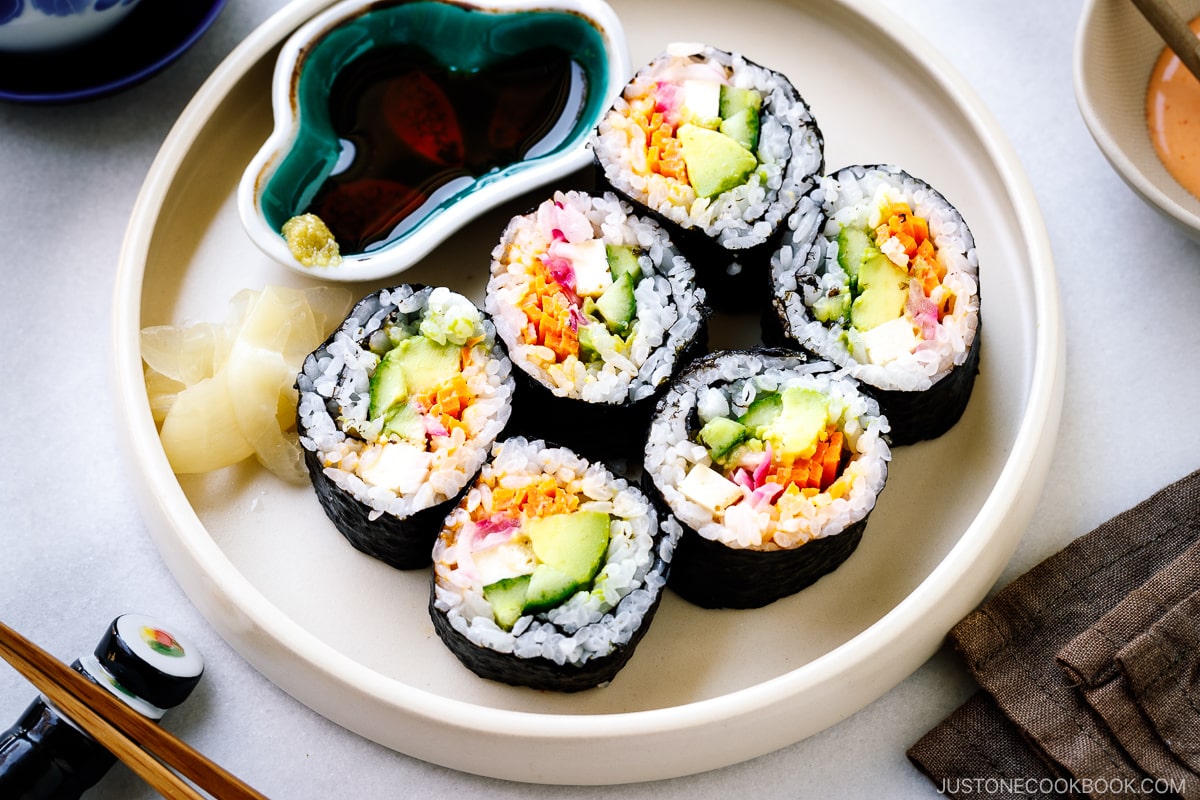
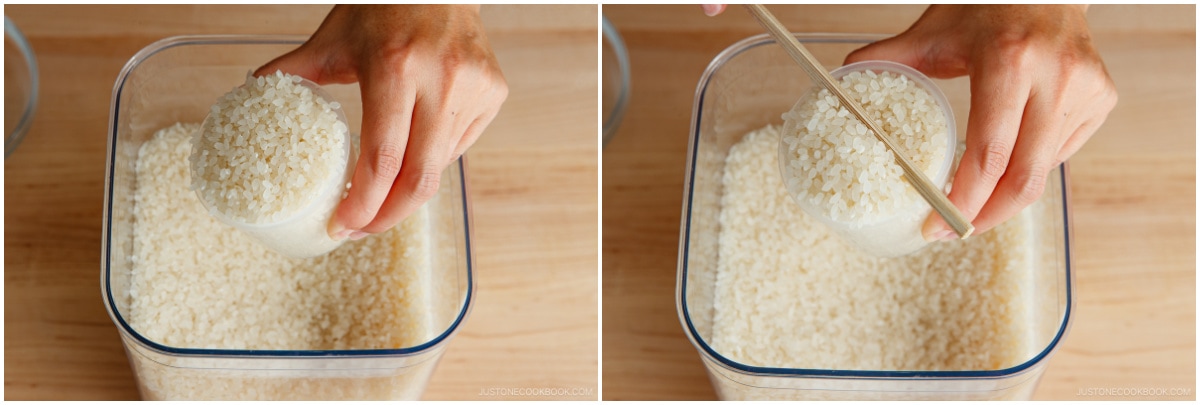
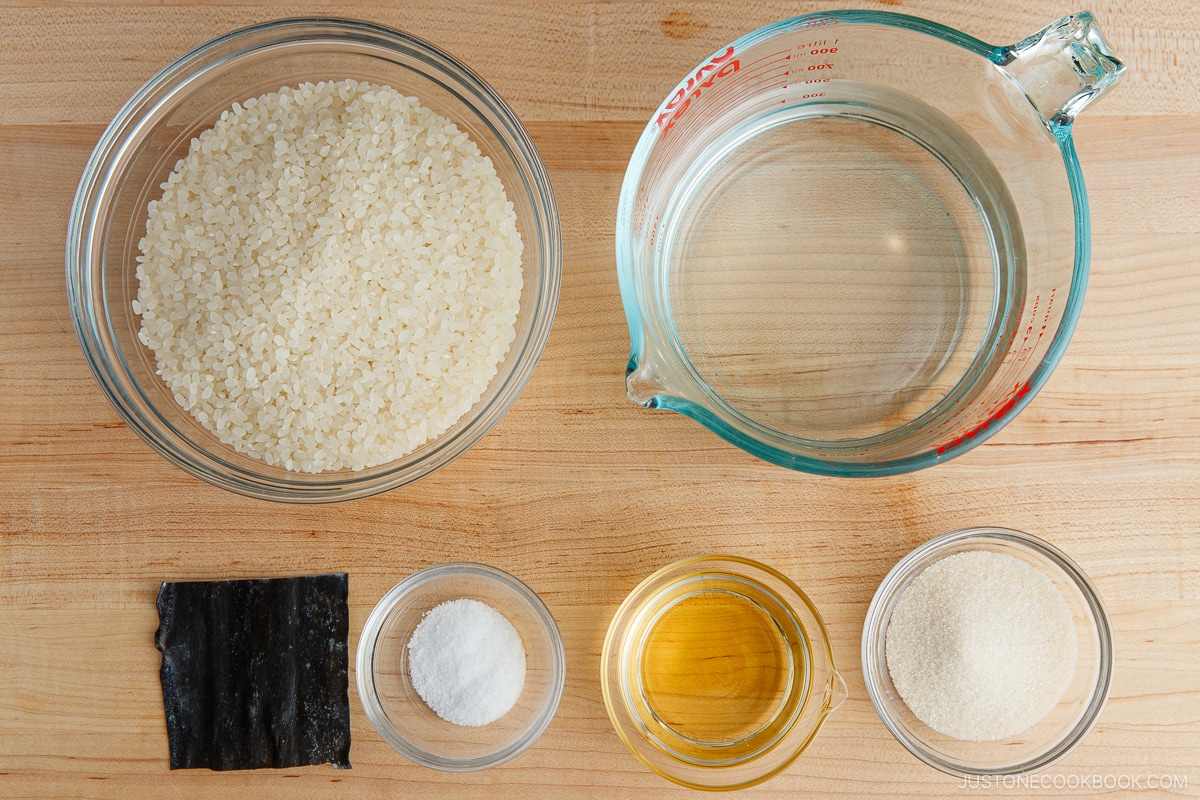
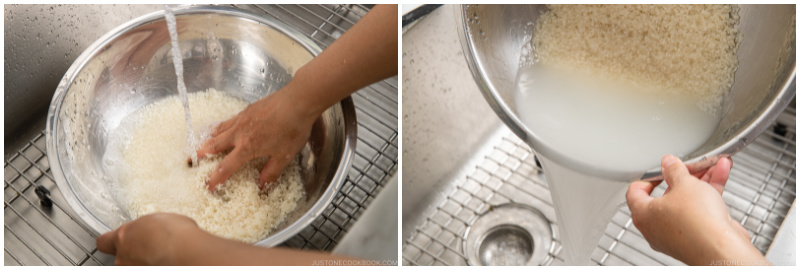
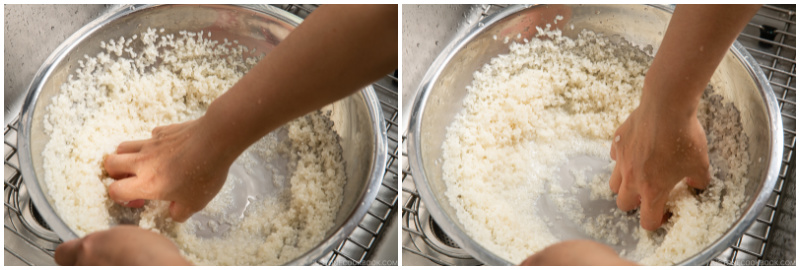
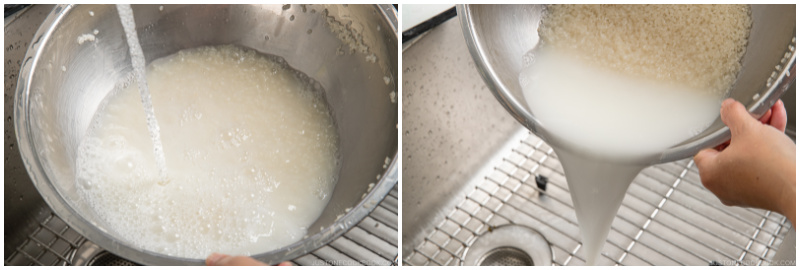
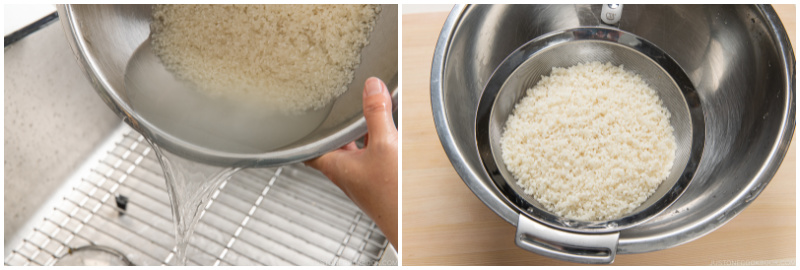
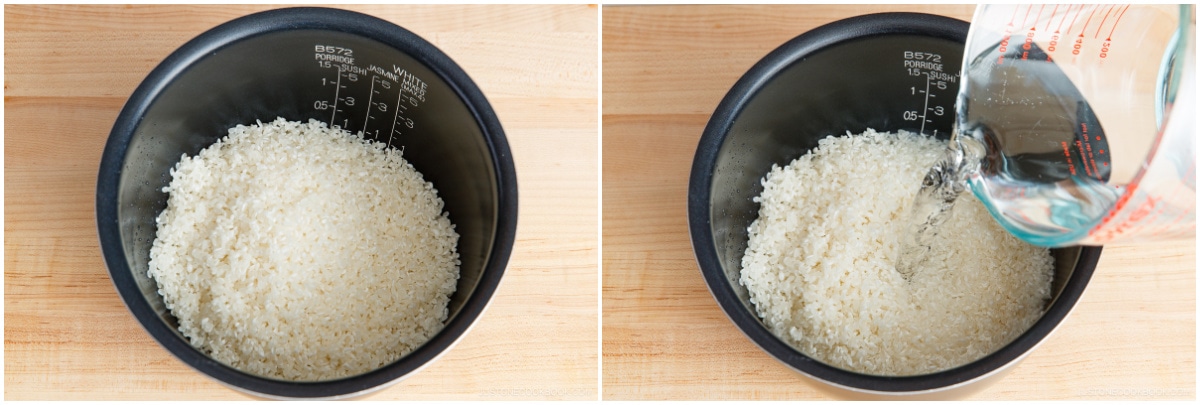
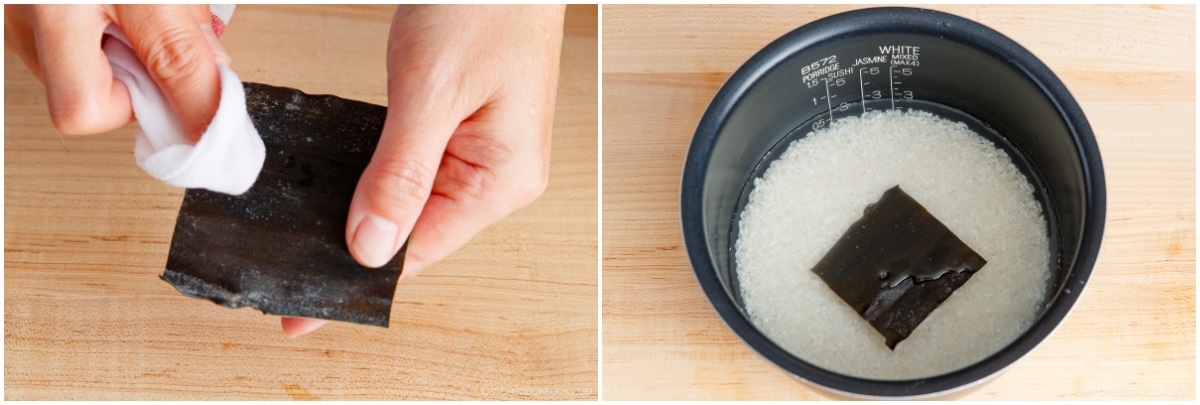
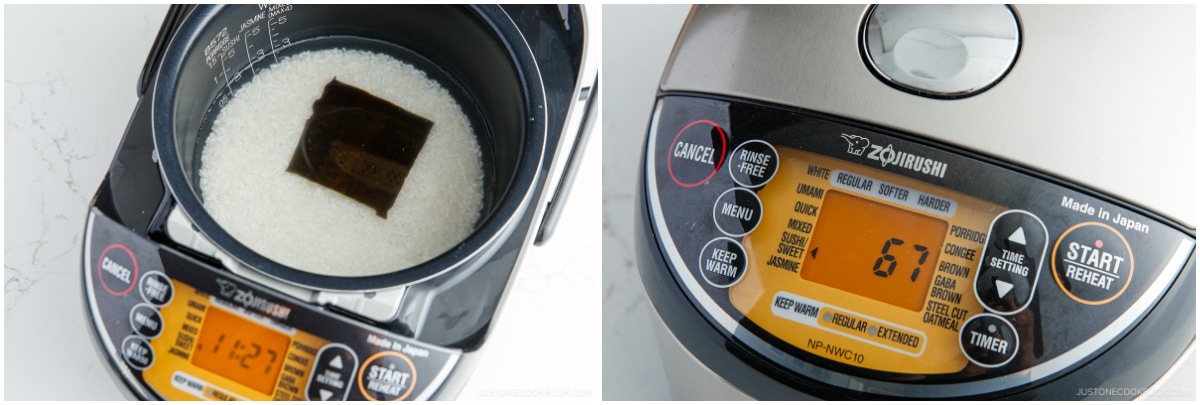
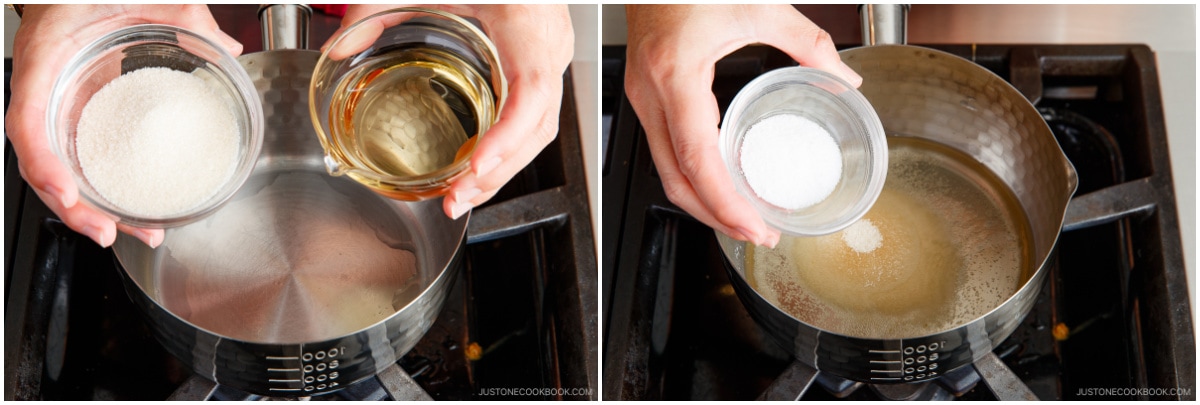
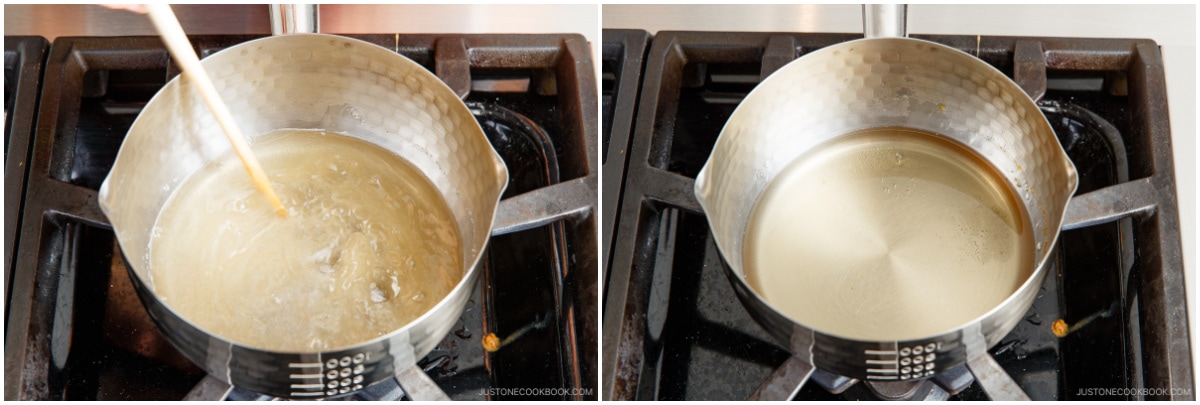
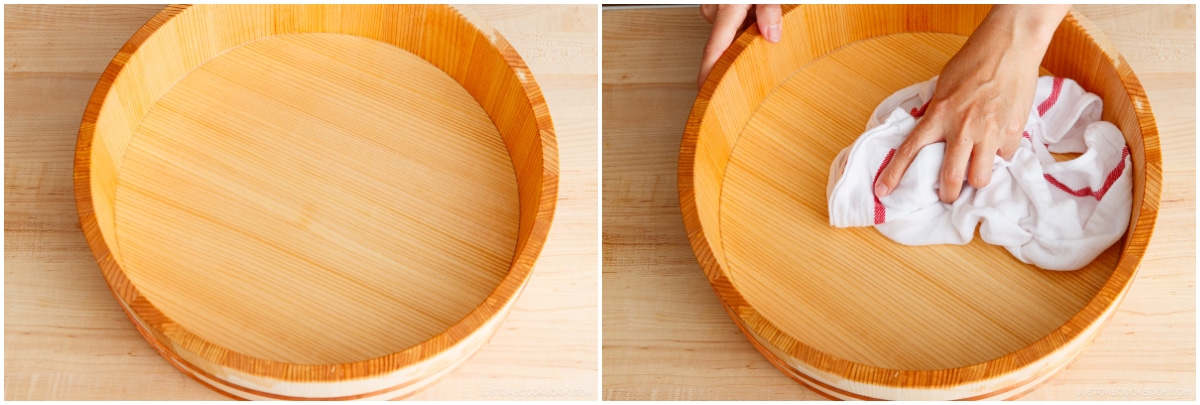
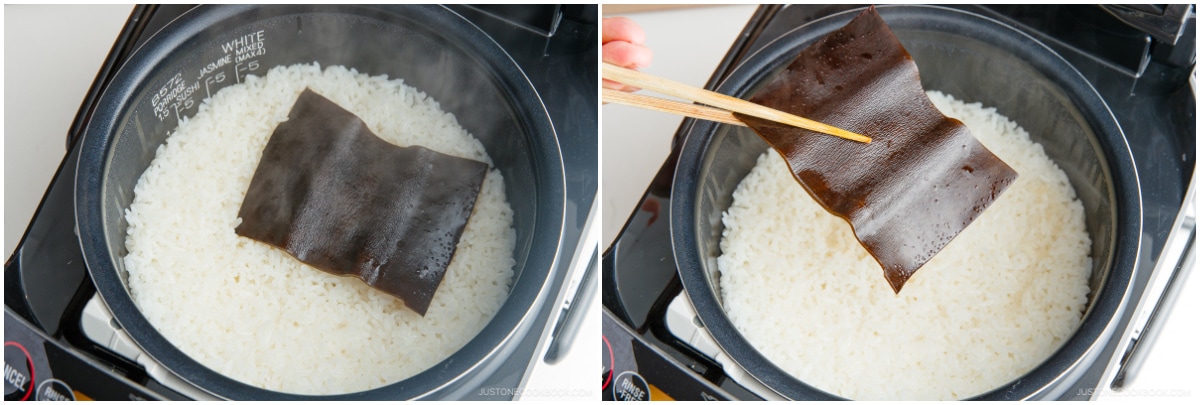
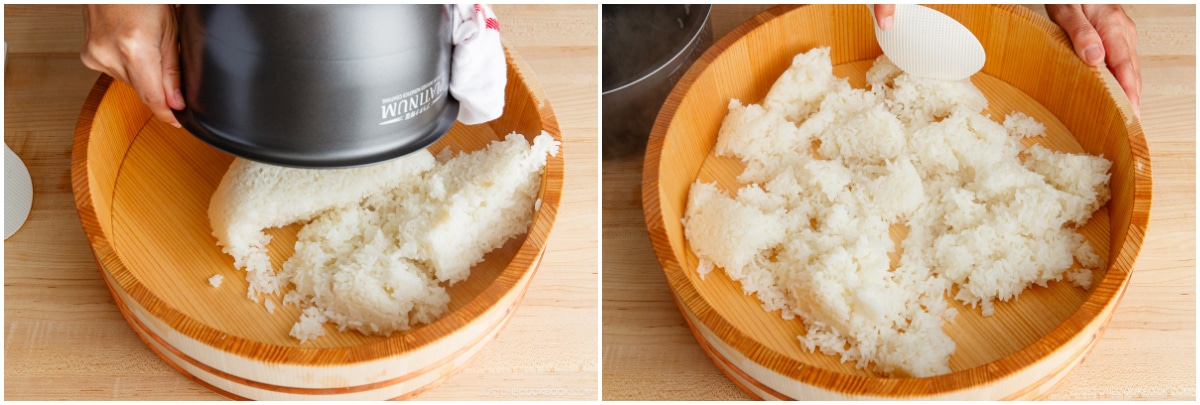
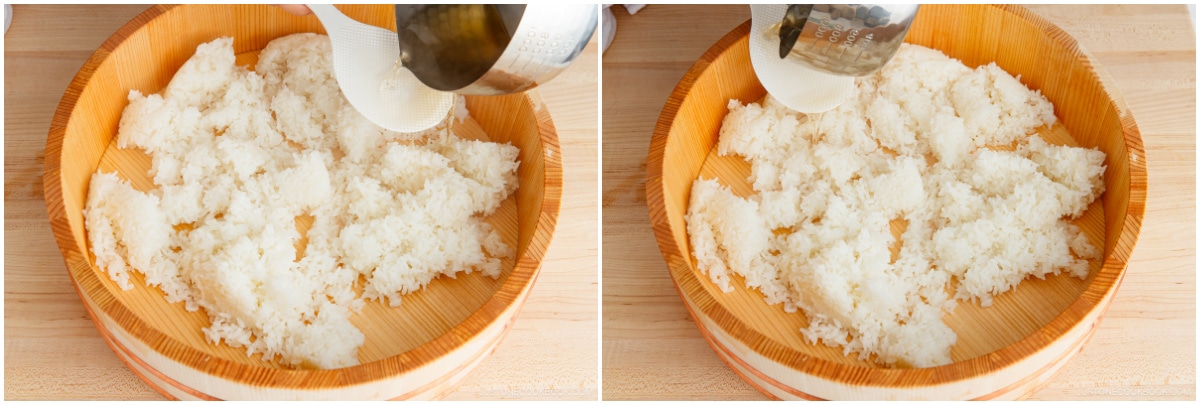
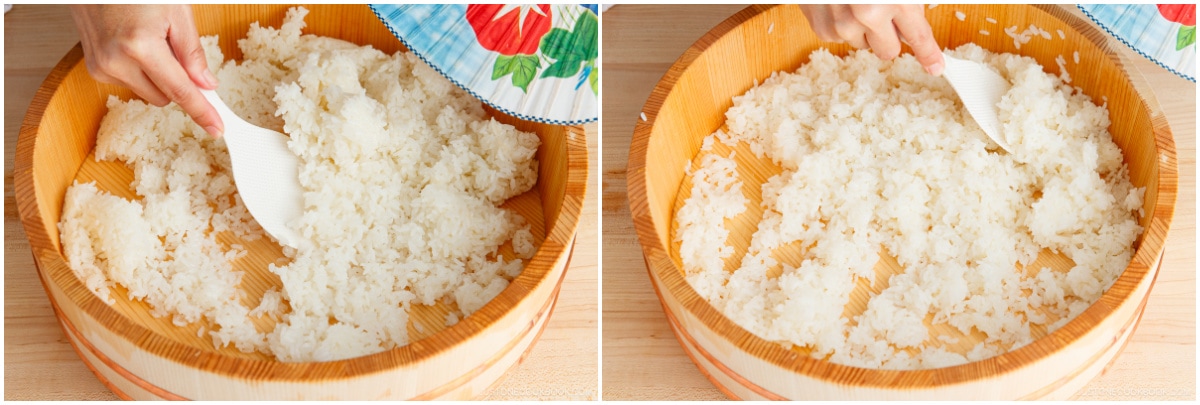
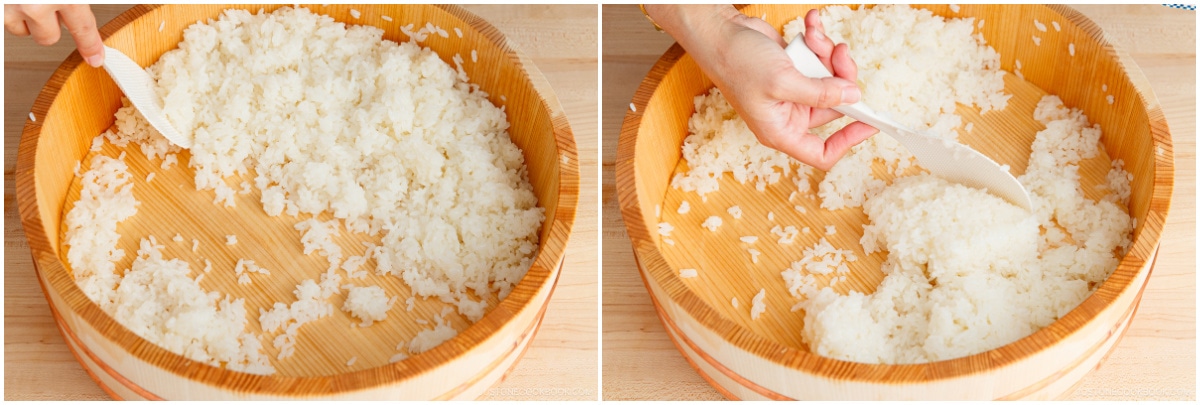
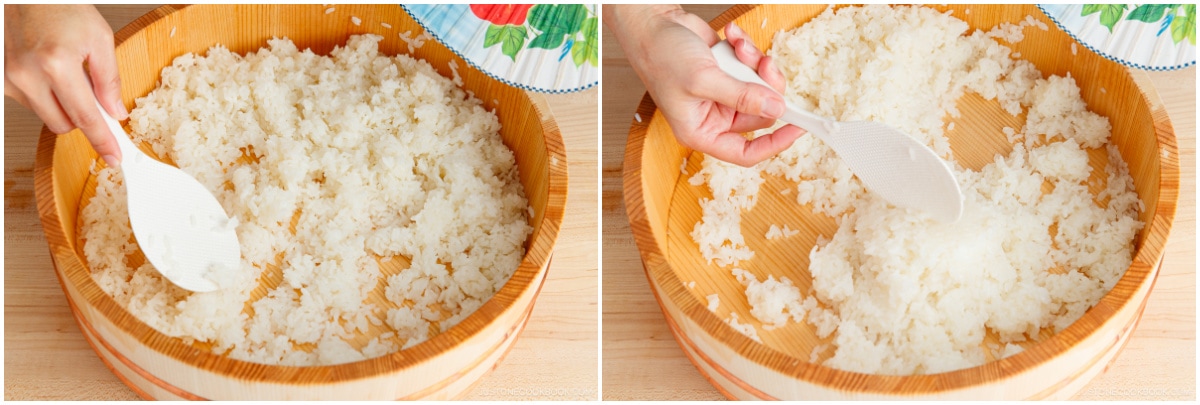
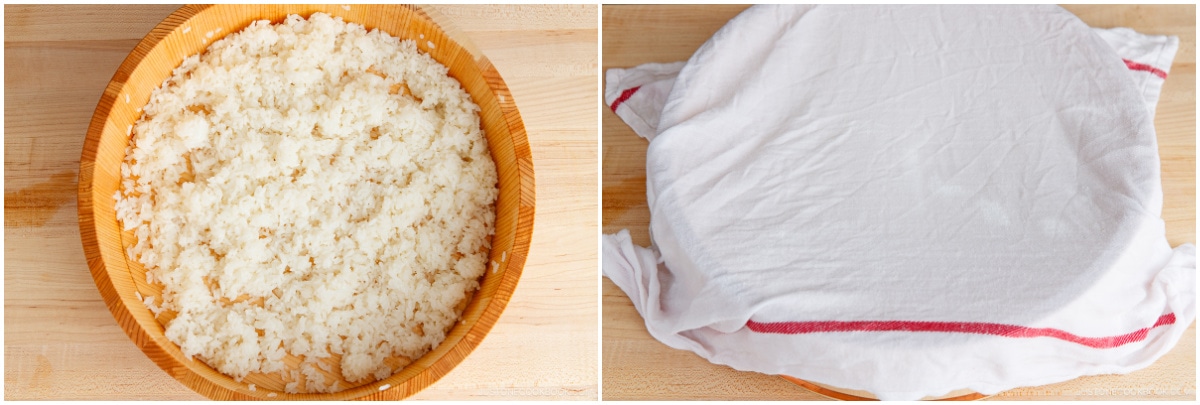










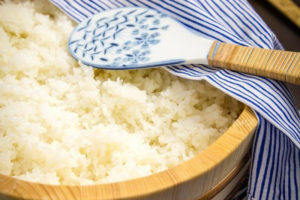
I work in chinese rest.but they make sushi is very bad. I word recipes for me!
Hi Danny! I hope you can make good authentic sushi rice following my recipe! 😉
Hi, I dont have rice vinegar. Can I use other vinegar?
Hi Joy! Unfortunately I only recommend to use rice vinegar. Other vinegar tastes and smells very different and you probably don’t want to use for sushi rice…. Hope this helps!
Thank you kindly for this recipe. Would this sushi/vinegar rice work well for onigiri as well?
Hi Laura! We only use sushi rice for making sushi. For Onigiri, we use regular steamed rice (basically the steamed rice before we pour the sushi vinegar to make sushi rice).
However, if you like that flavor of sushi rice, it’s totally okay. It’s just traditionally we do not use sushi rice for rice ball.
Hope this helps! 🙂
We’ve made the sushi rice several times and it is amazing. My 5 year old is demanding sushi every weekend, he loves it so much. I also find the description very detailed and helpful for foreigners.
I have a quick question, I would like to make the rice in advance but to consume it the same day. How many hours in advance can I cook it? Can I store it outside of the fridge? The room temperature is around 20 degrees Celsius. Thanx in advance.
Hi Maria! So happy to hear your son enjoy homemade sushi! In general, sushi vinegar keeps the rice safer than just leaving out the steamed rice at room temperature. I think 4-6 hours should be okay? Make sure to keep it in a cooler place and cover with a damp cotton cloth (breathable) instead of plastic wrap (avoid condensation etc). 🙂
Thank you for your kind feedback!
I love shabu shabu thanks for the recipe and your siteis very helpful
Hi Maria! I hope you enjoy my Shabu Shabu recipe! Thank you so much for your kind comment! 🙂
Please tell me how far in advance I can make California rolls, etc for a cocktail party? If I can prepare ahead of time, how do I cover them?
Hi Georgie! The problem is avocado. You have to squeeze lemon to keep the avocado’s green color longer, but still the avocado turn dark after a day. It doesn’t look as nice when we don’t see green avocado in the rolls. I’d recommend to prepare in the afternoon if the cocktail party is at night. If it’s on the same day, keep it at a cool place or refrigerate especially if it’s summer. I usually put rolls on a plate, cover with plastic wrap, and then cover with kitchen towel so rice doesn’t get too cold (and become too hard), before putting in the fridge. Hope this helps!
There are a lot of other rolls to make that will hold up well. I love avocado but as Nami said, the avocado will turn brown unless some type of citrus juice, lime or lemon, is added. There are other products that can be bought at the grocery store that contain citric acid, ascorbic acid (vit C), dextrose, etc. to be used to keep fruits/vegs from browning. Personally, a California roll would not be my first choice. I dislike imitation crab (my cats won’t even eat it). If you’re trying to appease an American palate, I’d lean towards a Philadelphia roll. That will keep well if pre-made the day of the party. Smoked salmon is preserved. Just don’t let the nori become soggy. Simple vegetable rolls like kappa maki (cucumber) are easy to make and will be liked by the vegetarians out there. Variations can include adding takuan (daikon pickle), beni shoga (red pickled ginger), green onion, or other Japanese pickle. This way one doesn’t have to worry about fish going bad. Main thing is to keep rice from becoming hard (yes, Nami!) and nori becoming too damp. Hope this helps!!!!
Thank you for your advice, Chieko! 🙂
Thanks!
can we use regular rice instead of japanese short grain rice ?
Hi Daniel! What’s “regular” rice? Long grain? Technically you should use short grain rice because each grain is stickier than let’s say long grain rice that are more separate from each other. If you try to make sushi, the rice “may” be not stick together. If you can find a small bag of short grain rice, I’d recommend to use it to make sushi. 🙂
Hi can I cook sushi rice with just coconut milk instead of vinegar? If so, do i need to add anything else to the coconut? Please can you give me instructions on how to cook sushi rice with coconut milk.
Hi Fatema! Thank you for asking! First of all, “Sushi Rice” in Japan means “vinegared rice” that is ONLY used for making sushi. So if you’re not going to make sushi, this is not the recipe you follow.
You might want to check How To Cook Rice recipe below:
https://www.justonecookbook.com/recipes/how-to-cook-rice/
I never used coconut milk to cook rice, so I’m not the best person to recommend/suggest how to cook it. Sorry I can’t be good help… 🙁
how to make that black roll …. is it fish skin ….. ?? ….
if no one wants to answer my question its fine …….. caz its a pathetic one
The black thing you see is called “Nori” and it’s sheet of seaweed. We use it for making sushi and other things. Hope this helps! 🙂
Thanks for the easy to follow instructions, BTW can I ask whats the reason for leaving the rice to soak for 30 mins?
Hi Jonathan! Thank you for checking my recipe! For Japanese rice, we usually let the rice soak for at least 15-30 minutes so the rice have enough moisture inside. Hope this helps. 🙂
Hi Nami
I have just discovered your site yesterday , I love it , looking forward to trying your recipes , Japanese cheesecake , and the green tea and white chocolate biscuits are on my to do list , also the cucumber wrapped sushi looks devine , cannot wait to try these , Thank you for your beautiful recipes , I am sure I will learn a lot from you ,
Kind regards , Maureen
Hi Maureen! Thank you for writing and I’m so happy to hear you found my site and enjoy reading! Good luck with the recipes, and I hope you enjoy them. 🙂
I didn’t know I need kombu when cooking sushi rice! I made some sushi at a party one time and back then, the recipe didn’t mention kombu. Was wondering why there’s some flavor missing and now I know why!
Hi Maggie! Yes, we usually put kombu to make sushi rice. 🙂
Hi, I am from Portugal and here we do not have many chinese stores (not the food ones) and here where I live we have none, so I would like to know if I cand do the fried tofu pockets only with regular tofu… I would buy a block and fry it? Many thanks, I looove ur blog 🙂
Hi Teresa! If you’re talking about the fried tofu pockets (like a pouch) like this below, then no, the process to make this type of fried tofu is different from a regular block of tofu to make…
But if you’re talking about “friend tofu” (no pockets), like Agedashi Tofu, then yes we do use regular tofu to make. The recipe is blow:
https://www.justonecookbook.com/recipes/agedashi-tofu-2/
hi how many sushi’s can that make?
Hi Prissie! If you make sushi roll, you will need about 1/2 cup of cooked rice per roll (about 1/4 cup of uncooked rice). For nigiri sushi, you can make 3-4 nirigi sushi with 1/2 cup cooked rice. Hope that helps. 🙂
Hi from Argentina!
I wonder if you have this same recipe (meaning your own traditional method) but without using a rice cooker!
***
Thanks for sharing lots of beautiful pictures and gorgeous dishes!
I’m a cook and I just love Japanese culture… it’s always awesome to find people like you, who share their family and/or traditional recipes. 🙂
Some day I will visit Japan and eat those wonderful meals in front of those awesome landscapes!!
Love your blooog :3
Cheers!
Paula.
Hi Paula! Thank you for your kind comment. I have to make a post on how to make rice without a rice cooker. It’s been on my list to blog, but haven’t had the time to create a post yet… Thanks for reminding me though!
I hope you can visit Japan one day! Thank you very much for your feedback! xo
I also would like to have the recipe without the rice cooker (I’m from Uruguay and we don’t really have access to this kind of kitchenware).
I’m browsing through your blog for the first time and I’m finding really interesting, will definetly come back!
Thank you Veronica! This is on my top of the list. Thank you for your request! 🙂
On an electric stove use a flame tamer to prevent Browning the bottom.
Thanks for your tip, Lisa!
Hi Nami!
I tried it (with the spicy tuna) and we all loved it! Thank you for the wonderful recipe! 🙂 I have a small family though and have some leftover sushi rice. How do I keep it? Do I just leave it in the bowl covered with the damp towel until tomorrow? I’m assuming the vinegar acts as a preservative. Or can I store it in the ref and reheat when I’m going to make sushi again?
It will depend on the climate you live in. If its cool place you could leave it out covered with plastic wrap but otherwise I recommend you to store in the fridge. :). Glad to hear you enjoyed this recipe! Thank you very much for your feedback!
It’s warm here so I’ll put it in the fridge. Thanks Nami! 🙂